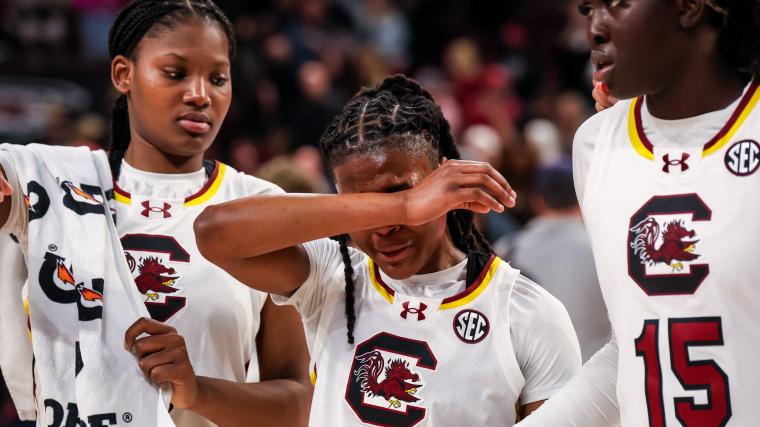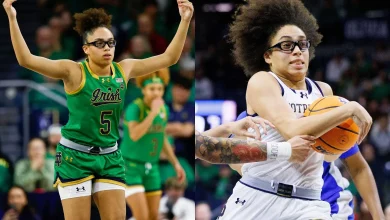UConn ended the Gamecocks’ 71-game home winning run by dominating No. 4 South Carolina.

In one of the most anticipated matchups of the season, No. 7 UConn delivered a decisive blow to No. 4 South Carolina, ending the Gamecocks’ 71-game home winning streak with a commanding 87-58 victory. This game was not just another regular-season contest—this was a statement. The victory was a reflection of UConn’s return to the top of women’s college basketball, while it also raised serious questions about South Carolina’s once-untouchable defense and home-court advantage.
The atmosphere at Colonial Life Arena in Columbia, South Carolina, was electric, filled with high expectations from Gamecocks fans who had watched their team dominate at home for more than two years. South Carolina, under head coach Dawn Staley, had become nearly unbeatable at home, and their 71-game home winning streak stood as one of the most impressive accomplishments in women’s college basketball history. But on this night, UConn’s collective brilliance swept aside the Gamecocks, exposing cracks in their defense and forcing their offense into unfamiliar territory. The loss marks a significant shift in the landscape of women’s college basketball as the Huskies’ performance sent shockwaves through the sport.
This article will take a deeper look at how UConn dominated South Carolina, what went wrong for the Gamecocks, and what the outcome means for both programs moving forward.
UConn’s Masterclass: Dominating Both Ends of the Court
UConn’s victory was built on a well-rounded, balanced performance that showcased the Huskies’ depth, experience, and ability to execute on both ends of the floor. While South Carolina had prided itself on its defensive prowess and physical play, UConn countered with a fast-paced offense and suffocating defense that left the Gamecocks no room to breathe.
Offensive Explosion: UConn’s Balanced Scoring Attack
One of the most impressive aspects of UConn’s performance was their balanced scoring. The Huskies didn’t rely on a single player to carry the load; instead, it was a team effort that overwhelmed South Carolina from every angle.
- Aaliyah Edwards, UConn’s powerful forward, was a dominant force inside, finishing with 23 points and 14 rebounds. Edwards was relentless in the paint, overpowering the South Carolina defense with her strength and finishing ability. Her work on the boards, both offensively and defensively, prevented South Carolina from gaining second-chance opportunities and stymied any efforts for the Gamecocks to establish momentum.
- Azzi Fudd, one of UConn’s sharpshooters, provided an additional scoring threat from the perimeter, contributing 19 points—many of them from beyond the arc. Fudd’s ability to stretch the floor was critical in opening up the paint for Edwards and other teammates, forcing South Carolina to adjust its defense to deal with UConn’s multi-dimensional attack.
- Paige Bueckers, UConn’s leader and floor general, added 15 points and 7 assists, orchestrating the offense and ensuring that the ball moved fluidly. Bueckers played with incredible poise, taking what the defense gave her and setting up teammates for easy scoring opportunities. Her leadership on the court was invaluable, as UConn maintained a high level of execution even when the Gamecocks tried to make a run.
- The Huskies also received contributions from Caroline Ducharme and Lou Lopez Senechal, who combined for 15 points. Ducharme’s ability to score in transition and Lopez Senechal’s versatility in both shooting and playmaking made UConn’s offense nearly impossible to defend, as the Gamecocks were forced to deal with multiple scoring threats.
UConn’s offense was efficient and unselfish. The Huskies shot 47% from the field and 39% from three-point range, creating open looks with crisp ball movement and constant player motion. This offensive fluidity stood in stark contrast to South Carolina’s struggles, particularly in the first half.
Defensive Dominance: UConn’s Intensity on the Ball
Defensively, UConn set the tone early. The Huskies’ full-court press and relentless defensive intensity gave South Carolina fits, particularly in their transition game. UConn’s defensive strategy was clear: pressure the ball, limit fast breaks, and force South Carolina into uncomfortable shots.
UConn’s defense was especially effective in limiting Aliyah Boston, South Carolina’s star forward, to just 14 points and 9 rebounds—well below her typical numbers. UConn’s defenders swarmed Boston every time she touched the ball, limiting her touches and making it difficult for her to establish any rhythm in the post. Boston, who had been the anchor of South Carolina’s inside game all season, simply couldn’t get free from the constant double-teams and aggressive defense.
On the perimeter, UConn made sure to contest every shot, forcing Zia Cooke and other South Carolina guards into difficult looks. Cooke, one of the Gamecocks’ top shooters, was held to just 7 points on 3-of-11 shooting, while the rest of the Gamecocks’ perimeter players struggled to get into any kind of offensive flow.
UConn’s defensive pressure was relentless, and their ability to disrupt South Carolina’s offense was a key factor in the blowout. The Huskies forced 18 turnovers and consistently disrupted South Carolina’s rhythm. Every time the Gamecocks seemed to get something going, UConn would quickly stifle their efforts, forcing bad shots or creating easy transition opportunities on the other end.
South Carolina’s Struggles: Defensive Issues and Offensive Stagnation
For South Carolina, this was a night to forget. The Gamecocks came into the game with the confidence that their home-court advantage would play a major role, but UConn quickly showed them that the Huskies were more than capable of silencing the home crowd and delivering a dominating performance.
Defensive Breakdown: UConn’s Ability to Exploit the Gamecocks
South Carolina’s defense, which had been their trademark throughout their 71-game home win streak, simply wasn’t up to the task against UConn. The Gamecocks allowed the Huskies to score at will, particularly in transition. South Carolina’s lack of defensive communication led to several easy fast-break opportunities for UConn, which they converted with clinical efficiency.
One of South Carolina’s primary defensive strengths—rebounding—also faltered. UConn out-rebounded the Gamecocks 42-29, controlling the glass and preventing South Carolina from establishing second-chance opportunities. The Huskies’ ability to control the boards kept them in control of the tempo of the game and limited South Carolina’s fast-break chances.
The Gamecocks also struggled to adapt to UConn’s perimeter game. South Carolina, which had been one of the top teams in defending the three-point shot, was forced to extend its defense, leaving gaps for UConn’s shooters. Fudd and Bueckers exploited these gaps, and as a result, South Carolina was left scrambling to adjust throughout the game.
Offensive Inconsistencies: Boston and Cooke Fall Short
On the offensive end, South Carolina’s star players struggled to find their rhythm. Aliyah Boston, who had been dominant in nearly every game this season, was rendered ineffective by UConn’s suffocating defense. Every time she touched the ball, she was met with double teams, and the Huskies made sure to collapse on her in the post, forcing her to either pass out of tough situations or take contested shots. Despite her efforts, Boston was unable to establish the kind of dominance in the paint that had been a hallmark of South Carolina’s offense.
Zia Cooke, another key figure for South Carolina, also had an off night. Cooke, known for her ability to create her own shot, was unable to break free from UConn’s defensive schemes. UConn’s pressure on the ball and quick rotations on defense forced Cooke into bad shot selections, and she ended the game with just 7 points, shooting only 27% from the field.
The lack of offensive execution compounded South Carolina’s issues, especially with their role players unable to step up in the absence of their stars. The Gamecocks shot just 38% from the field and were unable to find the kind of offensive flow that had propelled them to dominance earlier in the season. UConn’s defense, coupled with South Carolina’s missed opportunities and turnovers, left the Gamecocks unable to mount any serious challenge throughout the game.
UConn’s Statement Win: What It Means Moving Forward
UConn’s 87-58 victory over South Carolina is a statement win that has reverberated across women’s college basketball. The Huskies, who had been building momentum all season, demonstrated that they are back to being one of the top teams in the country. This win was a testament to their resilience, depth, and execution, as they exposed vulnerabilities in South Carolina’s game that other teams may now look to exploit in the future.
The Huskies’ balanced scoring, defensive intensity, and ability to control the game on both ends of the floor make them a formidable opponent for any team heading into the tournament. UConn’s return to form means that they are now serious contenders for a national championship and will be a force to reckon with as March Madness approaches.
South Carolina’s Road Ahead: Lessons from the Loss
For South Carolina, this loss serves as a wake-up call. While the Gamecocks are still one of the most talented teams in women’s college basketball, their vulnerabilities were laid bare by UConn.
South Carolina will need to adjust both offensively and defensively if they hope to reclaim their spot atop the rankings.
Head coach Dawn Staley has been known for her ability to make adjustments and get the best out of her players, and this setback will likely motivate her team to bounce back stronger. With players like Aliyah Boston and Zia Cooke still capable of dominating, the Gamecocks have the talent to make a deep run in the tournament—but they will need to find ways to tighten up their defense and improve their offensive execution in the weeks ahead.
A New Era for UConn, a Crucial Moment for South Carolina
UConn’s dominant win over South Carolina not only ended the Gamecocks’ historic home streak but also solidified the Huskies’ status as one of the top teams in women’s college basketball. With March Madness on the horizon, UConn has positioned itself as a true contender, while South Carolina will need to regroup and refine its play to remain in the national title conversation.
The victory was a testament to UConn’s resurgence under Geno Auriemma and a reminder that in women’s college basketball, the landscape can shift quickly. With UConn, South Carolina, and other teams like Stanford and LSU in the mix, the stage is set for an exhilarating postseason ahead.









